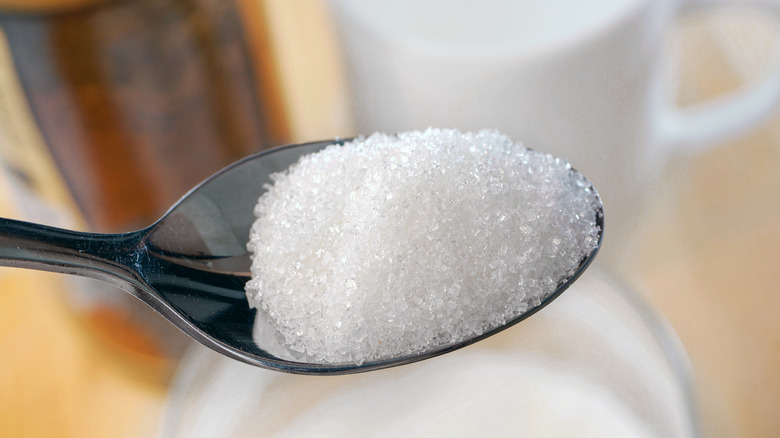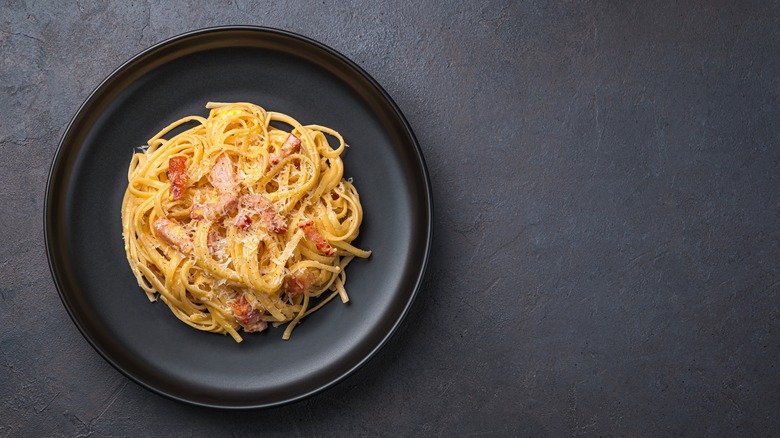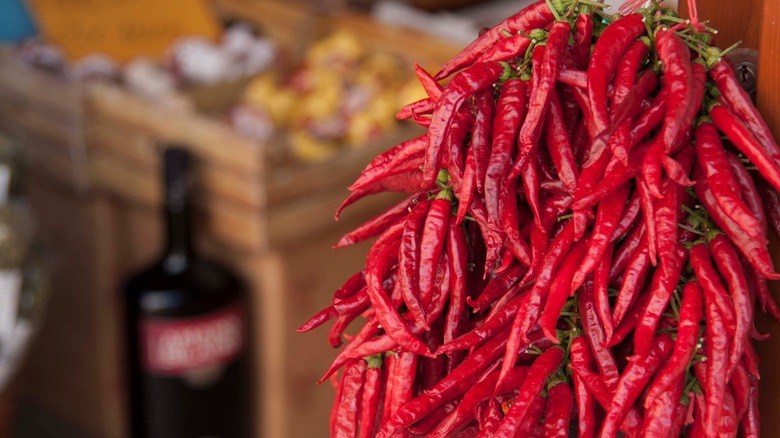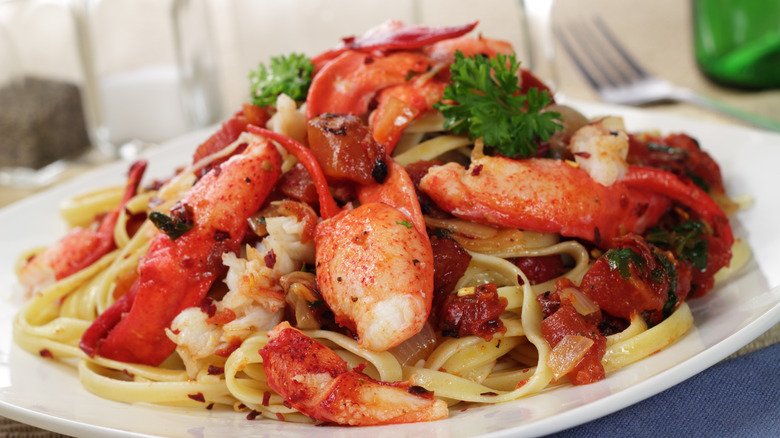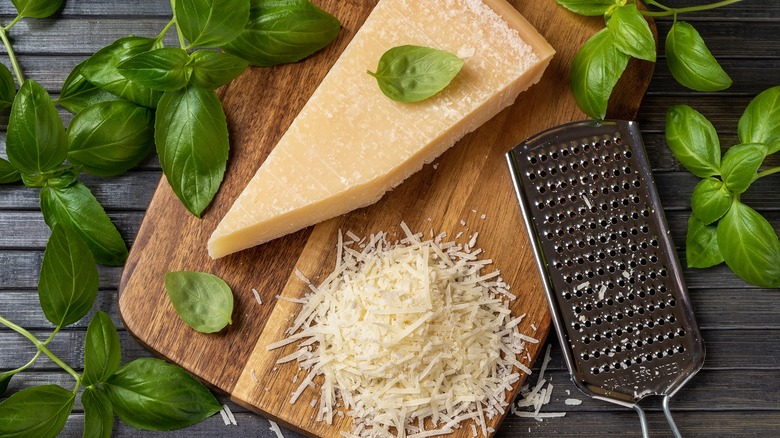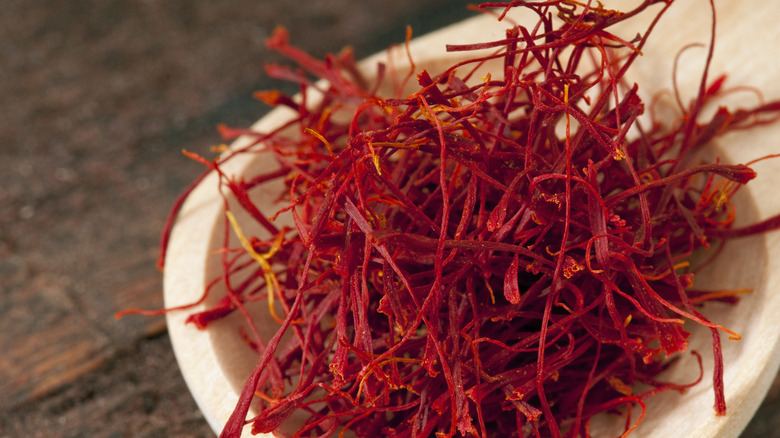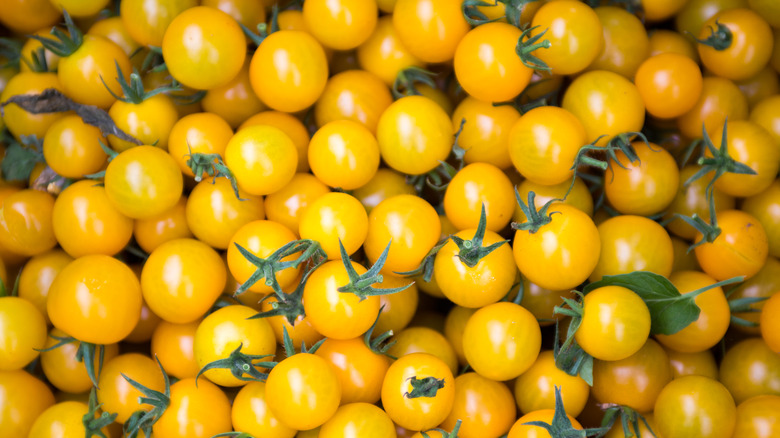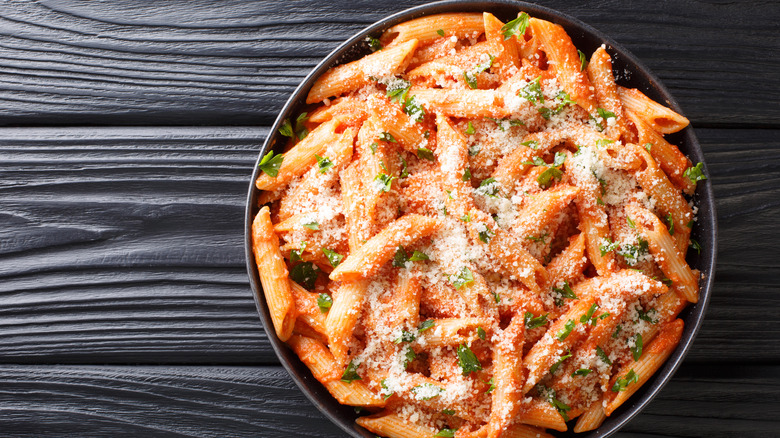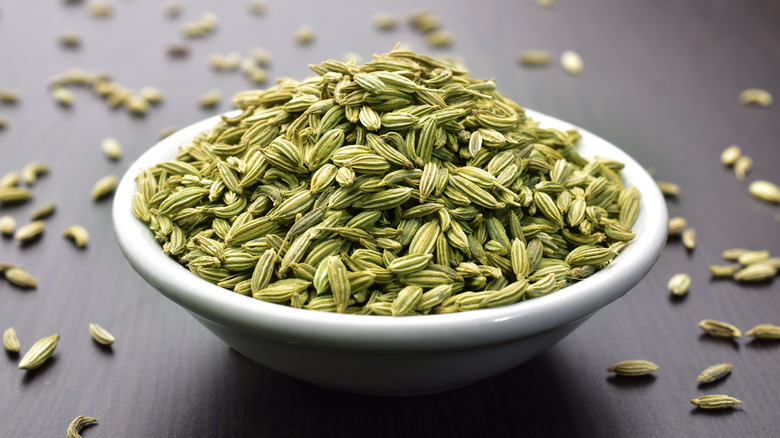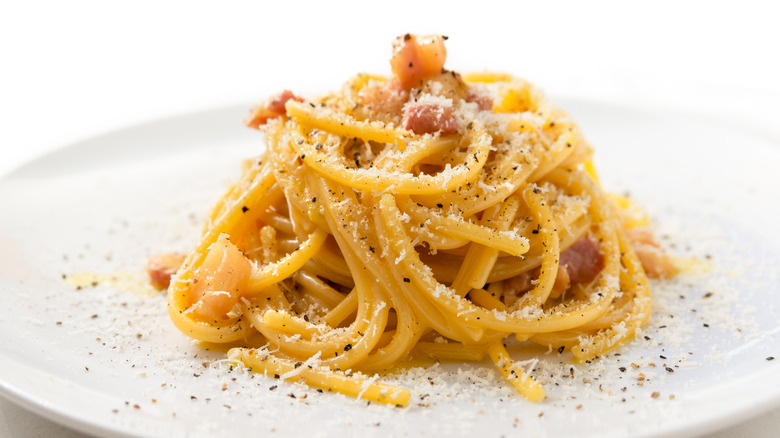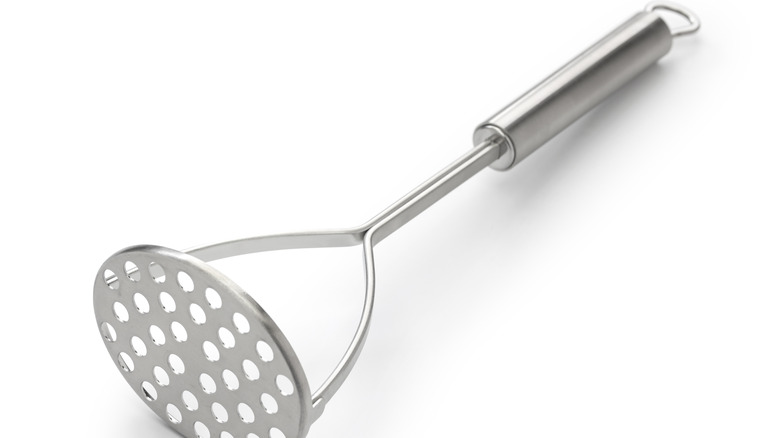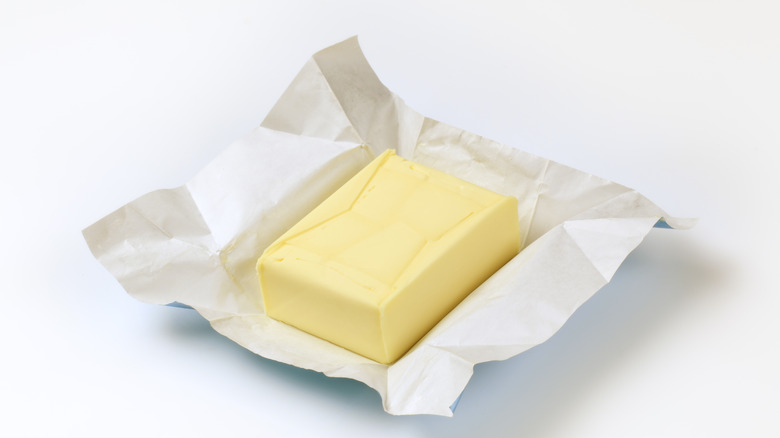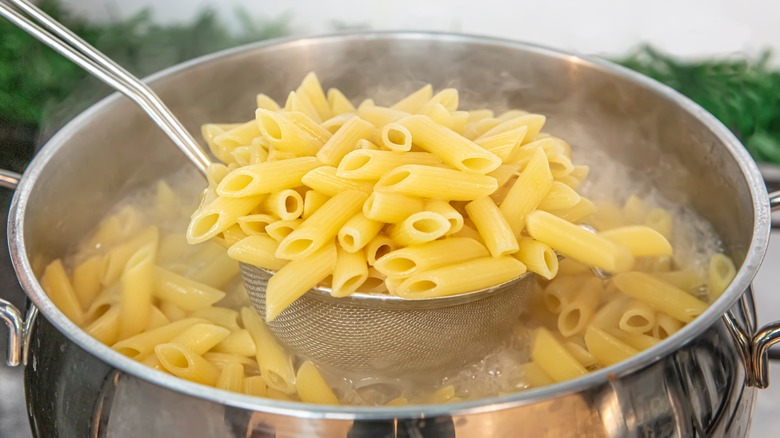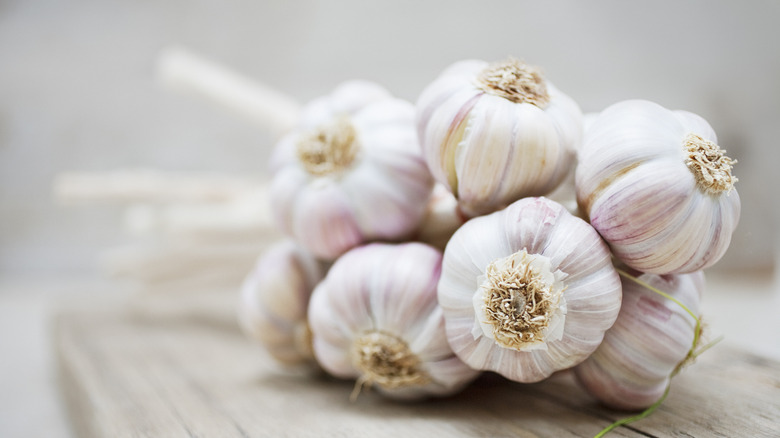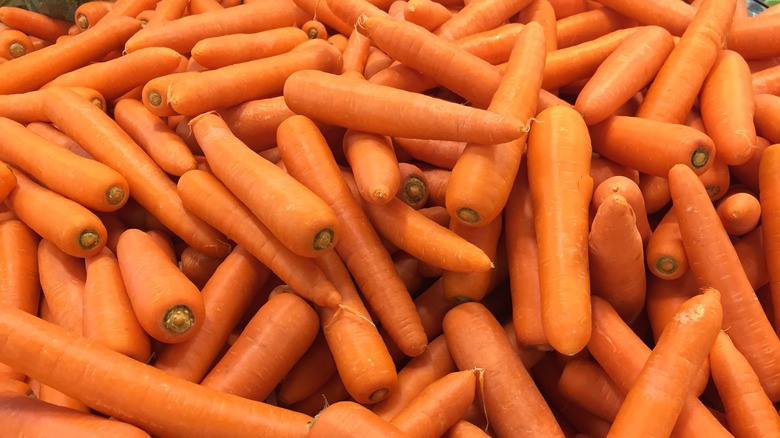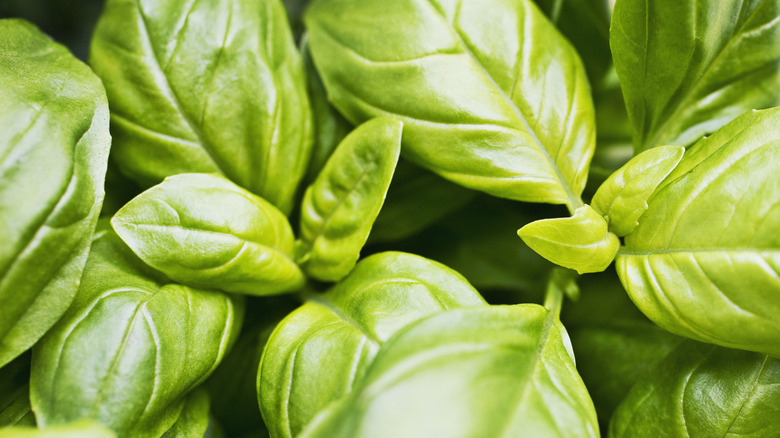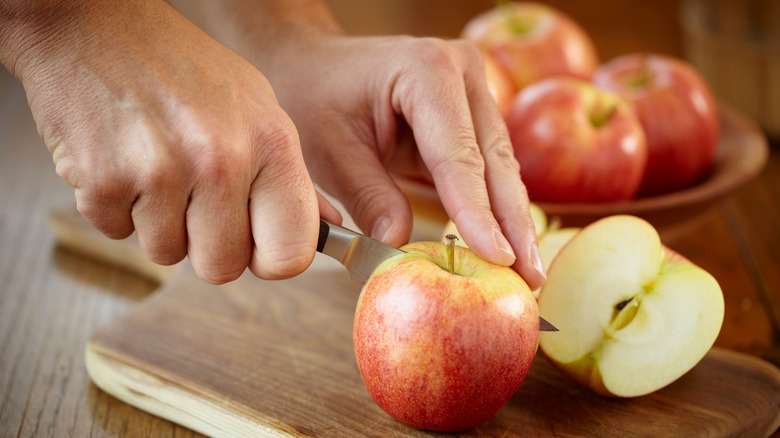19 Tips From Celebrity Chefs To Improve Homemade Pasta Sauce
Pasta is the perfect dinner dish when you're looking for something low-key or a little more extravagant. You can play with the ingredients, make your own fresh pasta, and craft fresh side dishes that will make you feel like you're dining out in Italy. But the key to making delicious pasta at home always starts with the sauce.
A balanced sauce — not too acidic, sweet, or simple — is the highlight of a good pasta dish. We've enlisted the help of celebrity chefs, who have made their fair share of pasta dishes over the course of their culinary careers, in finding the tips, tricks, and techniques to create a drool-worthy pasta sauce for any occasion. The best thing is that many of these tips utilize ingredients home cooks already have in their pantries and may only require one or two additional steps. So ditch the store-bought pasta sauce and try out some of these recommendations. Bon appetit!
1. Add a splash of red wine
While many choose to sip wine with their pasta, Ina Garten believes in adding it directly to the sauce. It's the secret ingredient to her best marinara sauce because it makes the sauce more robust. The Barefoot Contessa herself adds red wine to bolognese and plain marinara to help round out the flavors and make it a tasty pairing for pasta.
To make her wine-infused sauce, Garten adds Chianti to the pot with the onions and garlic after they are cooked and softened. The wine picks up any residual caramelized flecks of the alliums, which further gives the sauce a more powerful taste. She uses a half-cup of wine for her standard sauce recipe and proceeds to cook off some of the alcohol on medium-high heat before adding in the rest of her ingredients. This reduces the alcohol and makes the flavors meld together much more effortlessly.
2. Balance out the flavors with sugar
Do you add sugar to your tomato sauce? Although some pasta aficionados refuse to let the granules taint their recipe, celebrity chef Bobby Flay weighed in on the sugar in tomato sauce debate and argued that sugar does deserve a spot. He notes that this controversial ingredient is important to use if the tomatoes are tart because the sugar helps soften the flavor and makes the sauce less astringent. The best policy when adding this ingredient, which can easily shift the sauce into something that resembles more of a ketchup, is always to taste as you go.
Other chefs have argued that sugar is unnecessary in tomato sauce because modern tomato species have been scientifically bred to have higher sugar content. But underripe tomatoes or out-of-season varieties may need a little bit of a sweet kick to help carry the sauce.
3. Substitute olive oil for butter in carbonara
Spaghetti carbonara is a heavy dish, to say the least. It's ladened with eggs, pancetta, cheese, and butter — which can make it overwhelming to eat. Ina Garten gives carbonara a fresher, lighter twist by adding fresh vegetables like snow peas, asparagus, peas, scallions, and chives and making an ingredient swap. Instead of using butter, Ina Garten tosses the sauce with her favorite olive oil. This veggie-forward pasta is much lighter in flavor and can be paired with a light summer salad or bread for a whole meal.
She also reduces the heavy cream in the sauce by about half to make the dish a little less creamy. However, Garten notes that the cream can also be substituted entirely for water and a sprinkle of Parmesan to mimic the flavor. As she tells NPR, traditional carbonara is undoubtedly tasty, but it means "you want to take a nap afterward."
4. Incorporate Calabrian chiles for a bit of heat
Making a great pasta dish is all about pulling different flavor elements together and using ingredients to moderate one another. Calabrian chiles are the unique red chile Bobby Flay uses constantly on "Beat Bobby Flay" and in his pasta dishes. These spicy morsels, from the Calabrian region of Italy, have a distinct smokey and sweet quality, making them an ideal ingredient to add to a tomato sauce. Flay also uses the peppers for their spiciness — which is about the same Scoville rating as a cayenne.
The chef uses a jarred version of the chili for his squid ink pasta; he adds a small serving with the garlic before adding in the rest of his sauce ingredients. He'll also add Calabrian chile flakes to his bolognese sauce to add a bit of depth and complement the other aromatic ingredients.
5. Use lobster shells to infuse seafood flavors
We're always looking for ways to build a no-waste kitchen, and Emeril Lagasse's tip for making a lobster cream sauce will both make a more flavorful pasta accompaniment and use up the leftover shells. He uses seafood stock as the base for the sauce but will steep lobster shells in the stock to add a more robust fishy profile. The lobster shells also infuse a unique flavor profile, making this dish more lobster-y than just a bland seafood pasta.
For an optimal flavor profile, the shells should be allowed to steep in the stock with a mirepoix and herbs for at least an hour. Lagasse recommends storing the shells from your lobster tails in the fridge before making the stock. You can freeze the stock to use at a later date, but the sauce (with cream added) should not be frozen. When you're ready for a date-night dinner, pull out your frozen stock, finish the sauce, and add your pasta for some fresh-from-the-sea flavor, courtesy of Emeril Lagasse.
6. Boost umami with fish sauce
Fish sauce is the ingredient that everyone should have in their pantry. This fermented liquid is derived from anchovies, so it brings a strong umami flavor to any savory dish that you make. Chef David Chang substitutes Parmesan cheese for fish sauce in his red sauce recipe. In a video he shared on his Instagram, Chang explains how the fish sauce acts as a "natural MSG."
When adding this ingredient, which will change your tomato sauce forever, it's essential only to add it gradually — one teaspoon at a time — as the sauce simmers. If you don't have any fish sauce in your cabinet, you can substitute it with tinned anchovies. Add the small fish to the pan with the garlic and the onions to infuse the fishy flavor. And if you're avoiding fish altogether, check out vegan alternatives made with mushrooms or nori.
7. Toss the pasta with Parmesan before adding the sauce
Parmesan cheese is often thought of as an ingredient to add to pasta after it's finished cooking, but Giada De Laurentiis opts instead to add the cheese to the pasta before the sauce. As she explained to Williams Sonoma, her grandfather used to use this Neapolitan method of tossing the cooked pasta with cheese because "the sauce sticks to the cheese, which sticks to the pasta." This creates a wonderful synergy of sticking, which means every noodle is flavored with the perfect amount of sauce.
The other unexpected way to add cheese to your sauce is to stir it in while your pasta sauce is cooking down on the stove. This addition's timing means that the shaved Parmesan's umami flavor can infuse into the pasta sauce — providing a vegetarian alternative to other umami additions.
8. Use saffron and orange peel to brighten sauce for lasagna
If you feel like splurging on ingredients to elevate lasagna, take a piece of advice from the famous Julia Child and add some saffron threads and orange peel to the tomato sauce as it's simmering. Although you won't find these ingredients in other Italian dishes, they are both common ingredients in French bouillabaisse — a seafood stew Julia Child was all too familiar with. Besides these ingredients, Julia also adds a splash of vermouth to the béchamel for a stronger bite.
If you don't have any oranges handy, lemon zest is your next best bet. It's the punchy ingredient to amp up your tomato sauces because it will make the acidity of the tomatoes more pronounced.
9. Swap regular tomatoes for yellow ones
The key to making a great tomato sauce starts with your tomatoes. Standard red tomatoes tend to lack in the flavor department — especially if you're not picking them straight from the vine. According to Alex Guarnaschelli, the next best type of tomato to add to your sauce are yellow tomatoes. Her tomato sauce recipe substitutes the classic red San Marzano tomatoes with bright yellow beefsteak tomatoes.
She notes that these tomatoes are "fleshy" in texture and have less acid, which makes them an ideal tool to add texture to the red sauce without straying too much from the familiar tomato flavor. Guarnaschelli keeps her tomato sauce simple with other ingredients like olive oil, garlic, shallots, rice wine vinegar, seasoning, and a generous topping of Parmesan cheese.
10. Bake vodka sauce for more flavor
Penne alla vodka deserves high praise for its creaminess and ability to fill your belly up on a cold winter day. Ina Garten's simple trick will transform your vodka sauce by caramelizing, rather than burning, its flavors.
Instead of cooking her sauce on the stovetop, Garten brings them together in a pot and bakes it in the oven for an hour and a half at 375 degrees Fahrenheit. After her tomatoes, vodka, seasoning, and yellow onions are softened, she purees the sauce into the food processor and pulses until smooth. Then, she adds the signature ingredient, the cream, and simmers the sauce on the stove until warmed through. Lastly, she adds a bit of Parmesan and the pasta and serves the classic dish to her hungry guests.
11. Chop up fennel seeds for a flavorful red sauce
Fennel is an unexpected but flavorful seasoning for a range of Italian dishes. It's not particularly bitter or spicy, but it does have a unique licorice undertone. It's why Ina Garten makes her penne arrabbiata with fennel seeds. Instead of leaving the seeds whole in the sauce, Garten chops them with a knife into small pieces.
As she explains in a video posted on the Food Network's YouTube channel, this extra step allows the seeds to release more of their oils and infuse them into the sauce. "And fennel has this anise flavor that's just great, particularly with tomatoes," she explained. Garten will avoid using ground fennel because it loses its flavor and opts for this simple trick instead.
12. Be mindful of cooking your eggs in a carbonara
Carbonara can be a difficult dish to master at home because of one tricky ingredient: the eggs. The biggest mistake people make with carbonara, according to Nadia Munno, is frying the eggs. When the eggs are too hot, and little moisture is added, the pasta becomes a frittata. To get the ideal texture for the pasta, Munno, also called "The Pasta Queen," recommends incrementally adding pasta water to the eggs to keep the mixture soft. For the ideal texture, the eggs should also be kept at room temperature until they're added to the sauce and mixed carefully with a fork to prevent overwhipping.
Munno notes that other mistakes people make with carbonara include overcooking the pasta and coarsely grating the Pecorino Romano cheese. If you follow her tips, you will be on the way to carbonara perfection in no time.
13. Use a potato masher for better texture
Every recipe has its own special tool. But nothing replaces the ability to use a kitchen tool for things beyond its intended use. The unexpected tool Scott Conant uses for tomato sauce is a potato masher. In an interview with Serious Eats, the chef explained that growing up, he hadn't ever seen people mashing potatoes, but there was always a potato masher in a drawer. His mother and grandmother inspired him to use this tool to make tomato sauce.
A potato masher is an ideal instrument for making tomato sauce because it doesn't aerate the mixture as an immersion blender does. To make his sauce, he adds the seeded, halved tomatoes to a pot that has been warmed up with some olive oil. Then, he sprinkles the salt and uses a potato masher to break down the tomatoes into small pieces.
14. Make your sauce more unctuous with butter
Fat holds the key to flavor. It's the secret ingredient celebrity chef J. Kenji López-Alt uses for his tomato sauce. The chef adds a pat of butter to any sauce that is too acidic or watery. The chef recommends only adding the fat after you transfer the cooked pasta back to the sauce with a splash of pasta water. The butter can correct a with an overtly wet or pasty texture — and it will impart a buttery flavor.
The butter will make the pasta sauce creamy and help bring in unique flavors. It will also activate any fat-soluble flavor compounds in the sauce, making the dish taste brighter. While one pat of butter will likely do the trick, you can also taste and add more as needed.
15. Add pasta water to thicken non-dairy sauce
You might be wondering why you should add water to the pasta after it's finished cooking. After all — you don't want to make your dish too watery! But this magic water contains tons of starches, which can help elevate the texture of your dish.
Alex Guarnaschelli's go-to method to dress up non-dairy pasta sauce is adding water to the sauce. She makes a simple, non-dairy pasta sauce with olive oil, bright lemon, and toasted almonds — and encourages the sauce to stick to the pasta with a splash of water. Giada De Laurentiis' trick for silky carbonara is to temper the eggs in the pasta water before mixing it with the guanciale. This raises the eggs' temperature and ensures the mixture comes out perfectly smooth.
16. Improve any pasta sauce with Parmesan and garlic
Giada De Laurentiis knows a lot about pasta — especially considering that her grandfather ran several Italian specialty food stores after emigrating to the United States from Naples. One of her cooking tips for making pasta is to focus on classic Italian ingredients to upgrade the flavor of any pasta sauce — especially one she buys from the store.
Some of her favorite ways to amp up the flavor of pasta sauce include heating up the sauce on a stovetop with a little splash of olive oil and some garlic. As she shared in a blog post, she'll also slice a few inches of Parmesan cheese rind off and plop it into the sauce to infuse a savory, salty, and umami profile. De Laurentiis lets this piece simmer in the pot for about 15 minutes before removing it and finishing with basil and a pat of butter.
17. Use carrots to sweeten tomato sauce
We always say it's important to eat your veggies. And Giada De Laurentiis' tip to sweeten pasta sauce provides a hefty serving of Vitamin A. The celebrity chef uses carrots instead of sugar to enhance her pasta sauce. She peels and chops a whole carrot and adds it to the tomato sauce with the celery. It's critical to cook these hard vegetables down early so they have time to infuse flavor into the sauce as it's cooking. Then, she adds the tomatoes and herbs and cooks the mixture until soft and fragrant.
To ensure no bits of carrots are left floating around in the sauce, she opts to use a food processor. She shares that the sauce can be stored in the freezer for later use, or poured onto al dente pasta.
18. Cook the basil with the seasonings
The key to making a good sauce isn't just including all the ingredients — but also knowing when to add each to the dish. The Pasta Queen's basil trick for perfect pomodoro sauce is guaranteed to make you rethink how you add herbs to your dish. Nadia Munno makes her sauce by first straining the tomatoes to remove the seeds and peels — which she believes reduces some of the acidity. Instead of adding the fresh basil at the end of the recipe, Munno opts to add it to the pan with the garlic and sea salt.
Munno explained in an exclusive interview with Tasting Table. that she learned the trick from her grandmother. "A lot of people think it's a mistake in cooking, but it actually releases so much flavor into the olive oil," she said.
19. Consider adding fruit to your sauce
Tomatoes aren't the only fruit that deserves a special spot in your tomato sauce recipe. The Pasta Queen says your pasta sauce may be missing fruit — and all of the flavor and textural benefits it brings to a sauce. Nadia Munno loves experimenting with these ingredients and pairing them together to take her sauce to a new level.
One of her favorite pairings is apples and sausage. She uses green apples to give the sauce a bit of sourness with subtle, sweet notes. Munno recommends picking fruits seasonally — and there's no shortage of options at any time of year. Munno has tried orange canteloupe and prosciutto for a twist on the Italian prosciutto e Melone appetizer. In the summer, a berry and ricotta pasta dish could also provide seasonal flavors and a bright pop of color to a pasta dish.


